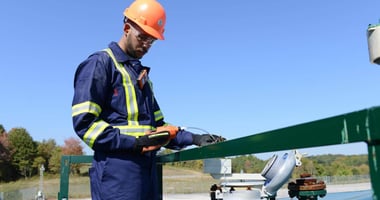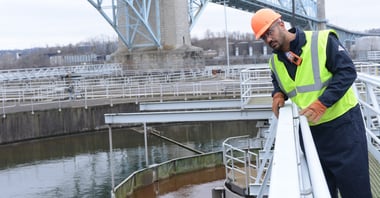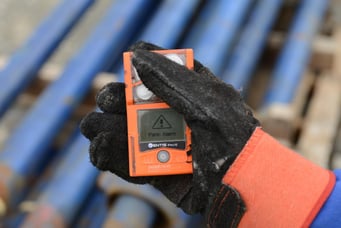On a regular Tuesday afternoon, you send a maintenance contractor out to a remote station to perform a routine check on some of your equipment. Your contractor drives out to the nearest access road, parks his truck, and walks over to the site. When he gets there, his personal gas monitor alerts him to high levels of dangerous gases. He knows he should call for backup, but it could be another hour before a peer can help. He has seen this issue before, so he thinks he can make a quick fix. He silences the alarm on his monitor, bends down to start working, and is overcome by the gases.
When you haven’t heard from the contractor by the next day, you ask around the shop. Nobody has seen him. You remember he was headed out alone to one of your remote locations the last time you saw him. You send someone to look for him – but by then, it’s too late.
You think about who will deliver the news to the man’s family and what you would do differently if you could turn back the clock.
Manual Check Ins are Not a Lone Worker Monitoring System
Situations like this are the devastating reality for too many lone workers. Employees working alone, like contractors, upstream and midstream oil and gas workers, utility workers, and many more face the same hazards as their on-site peers, but they can’t rely on a coworker or passerby to help them in an emergency. When they face danger on the job, it could be hours or even days before help arrives. The independent work that many enjoy is the very same thing that puts these workers at such a high risk.
Many companies rely on manual check ins for their lone worker policy, where workers contact safety managers at pre-determined intervals to confirm their status. If you rely on manual check ins, your workers are at risk. When a worker misses a check in, what do you do? Do you assume they just forgot? Or do you call for help, hoping it’s not a false alarm? Your choice makes the difference between a tragedy or worker going home safely.
On top of that, manual check ins take valuable time. While they may only take about a minute a piece, the time adds up faster than you think. If workers check in five times a day, 20 days a month, for a team of 12, you’re losing 20 hours of valuable work time each month – and that’s before accounting for lost productivity in the minutes before and after check ins.
In some parts of the world, lone worker regulations are raising awareness that companies need to account for lone workers at regular intervals and at the end of each shift by sight or verbal communication. Protecting lone workers presents special challenges, however, even in an era of constant connectivity. Many companies assume that because workers have cell phones, they can always call for help. But the truth is, there are many cases in which it’s unsafe or against procedure to carry a cell phone on the job. In cases where a worker can carry a cell phone, that doesn’t guarantee service. It’s common for lone workers to be in a remote area in which cell phone service is unavailable, rendering useless phone calls or other smartphone apps designed for lone worker protection.
To avoid falling into this safety trap, you need a modern lone worker monitoring system that doesn’t rely on manual check-ins, which are easy to miss, or cell phones, which have fallible service. Instead, use a lone worker monitoring system with multiple connectivity options specifically designed to address the safety challenges lone workers face day in and day out.
Tools for Lone Worker Monitoring
Many devices, including personal gas detectors, have connectivity features that transfer information about an employee’s work environment back to safety personnel on site. Although connectivity features are a tremendous step forward in safety monitoring and protecting our most vulnerable employees, not all connected devices deliver the same level of protection.
Here’s what you should look for in a lone worker monitoring system to ensure your workers have the lifeline to safety they need:
- Integrated Solution – Many lone worker monitoring devices on the market today are one-trick ponies. They can provide GPS tracking or a panic button or a man down alert or gas detection with live monitoring – but lone workers often need all of these features in one device. The more devices you add to a worker’s gear, the more likely it is that one will be lost, left behind, or run out of power. When investing in a device to connect lone workers to safety, look for one that gives them all the tools they need in one package.
- Automatic Check Ins – The goal of a lone worker monitoring system is to make your workers’ lives easier and safer. One way to do that is by eliminating manual check ins in favor of automatic updates. Today, some gas detectors and lone worker monitoring systems can automatically relay live updates on location, gas hazards, and worker status to safety contacts.
- Automatic Failover Connectivity – Lone workers are often dispatched to remote areas with little to no cellular coverage. If your lone worker monitoring solution relies on cell connectivity alone, your worker will be without a lifeline at some point. When that happens, the mobile worker is truly alone, and safety personnel have no visibility into what hazards they face or where they’re located. If something were to happen, such as an H2S alarm with no response, safety personnel would not know to send help. Your lone worker device absolutely must have automatic failover connectivity through another method. Cellular and satellite are an ideal combination to ensure a worker is connected in even the most remote locations.
- Live Monitoring and Alerts – You need live monitoring to show you where a worker is located at any given moment, but you should also expect real-time alerts. Nobody has time to constantly monitor a map of worker locations, so you should find a lone worker monitoring solution that offers instant text or email alerts that grab your attention. Those alerts should include the worker’s name, location, and reason for the alert – whether it’s a man-down alarm, panic/SOS situation, or exposure to a gas hazard.
- Infrastructure to Connect Devices – Most lone worker monitoring systems relay live data through a gateway back to safety personnel on site. Unfortunately, some of these gateways need extra infrastructure for every few monitors. With today’s technology, you should be able to connect devices with one gateway, which could lead to thousands of dollars in cost savings.
- Automatic Connectivity – Being a lone worker is hard, so don’t add the burden of troubleshooting connectivity issues. The best lone worker monitoring systems automatically connect devices in the field to cloud monitoring systems as soon as they’re powered on – no questions asked.
- No Maintenance – Look for a lone worker monitoring system with a no maintenance gateway – one that can run from a power supply like a vehicle that won’t require charging or cables.
Looking out for the safety and well-being of your workers is a huge responsibility, but it’s one you don’t have to shoulder alone. Lone worker monitoring devices like the TGX™ Gateway paired with the Ventis® Pro5 Multi-Gas Monitor give your workers a reliable lifeline to safety, so you can avoid situations like the one presented here. With someone always watching out for your lone workers, you’ll never have to live with the regret of, “If only I had known he needed me.”
If you choose your lone worker monitoring system carefully, you can breathe easily knowing you have complete visibility into what your workers are experiencing, even when they’re miles away.
Protect your lone workers with the TGX Gateway.



